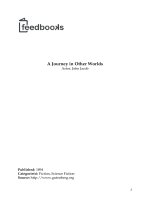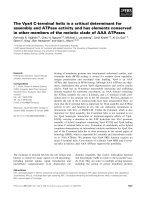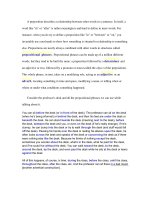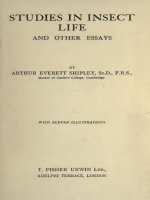In other words a coursebook
Bạn đang xem bản rút gọn của tài liệu. Xem và tải ngay bản đầy đủ của tài liệu tại đây (4.53 MB, 353 trang )
In Other Words
In Other Words is the definitive coursebook for students studying translation.
Assuming no knowledge of foreign languages, it offers both a practical and theoretical guide to translation studies, and provides an important foundation for training
professional translators.
Drawing on modern linguistic theory, this best-selling text provides a solid base
to inform and guide the many key decisions trainee translators have to make. Each
chapter offers an explanation of key concepts, identifies potential sources of translation difficulties related to those concepts, and illustrates various strategies for
resolving these difficulties. Authentic examples of translated texts from a wide
variety of languages are examined, and practical exercises and further reading are
included at the end of each chapter.
The second edition has been fully revised to reflect recent developments in the
field and new features include:
●
●
●
●
●
A new chapter that addresses issues of ethics and ideology, in response to
increased pressures on translators and interpreters to demonstrate accountability and awareness of the social impact of their decisions.
Examples and exercises from new genres such as audiovisual translation,
scientific translation, oral interpreting, website translation, and news/media
translation.
New project-driven exercises designed to support MA dissertation work.
Updated references and further reading.
A companion website featuring further examples and tasks.
Written by Mona Baker, a leading international figure in the field, this key text is the
essential coursebook for any student of translation studies.
Mona Baker is Professor of Translation Studies at the University of Manchester,
UK. She is co-founder and editorial director of St. Jerome Publishing which
specializes in translation studies. She is also co-Vice President of the International
Association of Translation and Intercultural Studies (IATIS).
In Other Words
A coursebook on translation
Second edition
Mona Baker
First published 1992
by Routledge
This edition published 2011
by Routledge
2 Park Square, Milton Park, Abingdon, Oxon OX14 4RN
Simultaneously published in the USA and Canada
by Routledge
270 Madison Ave, New York, NY 10016
Routledge is an imprint of the Taylor & Francis Group, an informa business
This edition published in the Taylor & Francis e-Library, 2011.
To purchase your own copy of this or any of Taylor & Francis or Routledge’s
collection of thousands of eBooks please go to www.eBookstore.tandf.co.uk.
© 1992, 2011 Mona Baker
The right of Mona Baker to be identified as author of this work has been asserted
by her in accordance with sections 77 and 78 of the Copyright, Designs and
Patents Act 1988.
All rights reserved. No part of this book may be reprinted or reproduced or utilized
in any form or by any electronic, mechanical, or other means, now known or
hereafter invented, including photocopying and recording, or in any information
storage or retrieval system, without permission in writing from the publishers.
British Library Cataloguing in Publication Data
A catalogue record for this book is available from the British Library
Library of Congress Cataloging-in-Publication Data
Baker, Mona.
In other words : a coursebook on translation / Mona Baker. – [2nd ed.].
p. cm.
Includes bibliographical references and index.
1. Translating and interpreting. I. Title.
P306.B25 2011
418'.02–dc22
2010031445
ISBN 0-203-83292-2 Master e-book ISBN
ISBN: 978-0-415-46753-7 (hbk)
ISBN: 978-0-415-46754-4 (pbk)
ISBN: 978-0-203-83292-9 (ebk)
To Ken
Contents
List of figures
List of tables
Preface to the second edition
Preface to the first edition
Acknowledgements
1
2
xi
xii
xiii
xv
xvii
Introduction
1
1.1 About the organization of this book
1.2 Examples, back-translations and the languages of illustration
Suggestions for further reading
Note
4
6
8
8
Equivalence at word level
9
2.1 The word in different languages
9
2.1.1 What is a word?
2.1.2 Is there a one-to-one relationship between word and meaning?
2.1.3 Introducing morphemes
2.2 Lexical meaning
2.2.1 Propositional vs expressive meaning
2.2.2 Presupposed meaning
2.2.3 Evoked meaning
2.3 The problem of non-equivalence
2.3.1 Semantic fields and lexical sets – the segmentation of
experience
2.3.2 Non-equivalence at word level and some common strategies
for dealing with it
Exercises
Suggestions for further reading
Notes
9
10
10
11
11
12
13
15
16
18
44
47
49
viii
IN OTHER WORDS
3
Equivalence above word level
51
3.1 Collocation
52
3.1.1
3.1.2
3.1.3
3.1.4
Collocational range and collocational markedness
Collocation and register
Collocational meaning
Some collocation-related pitfalls and problems in translation
3.2 Idioms and fixed expressions
3.2.1
3.2.2
3.2.3
3.2.4
4
Idioms, fixed expressions and the direction of translation
The interpretation of idioms
The translation of idioms: difficulties
The translation of idioms: strategies
67
68
69
71
75
Exercises
Suggestions for further reading
Notes
86
90
91
Grammatical equivalence
92
4.1 Grammatical vs lexical categories
4.2 The diversity of grammatical categories across languages
93
95
4.2.1
4.2.2
4.2.3
4.2.4
4.2.5
Number
Gender
Person
Tense and aspect
Voice
4.3 A brief note on word order
4.4 Introducing text
4.4.1 Text vs non-text
4.4.2 Features of text organization
5
54
56
57
58
96
99
104
108
112
120
121
121
123
Exercises
Suggestions for further reading
Notes
124
127
129
Textual equivalence: thematic and information structures
131
5.1 A Hallidayan overview of information flow
133
5.1.1 Thematic structure: theme and rheme
5.1.2 Information structure: given and new
5.2 The Prague School position on information flow: functional
sentence perspective
5.2.1 Linear arrangement and thematic status in FSP
5.2.2 Linear arrangement and marked structures in FSP
133
156
170
173
174
CONTENTS
5.2.3 The tension between word order and communicative function:
a problem in translation?
5.2.4 Suggested strategies for minimizing linear dislocation
6
7
Exercises
Suggestions for further reading
Notes
181
186
187
Textual equivalence: cohesion
190
6.1 Reference
6.2 Substitution and ellipsis
6.3 Conjunction
6.4 Lexical cohesion
Exercises
Suggestions for further reading
Notes
190
196
200
210
223
227
228
Pragmatic equivalence
230
7.1 Coherence
230
7.1.1 Coherence vs cohesion
7.1.2 Is coherence a feature of text or situation?
7.2 Coherence and processes of interpretation: implicature
7.3 Coherence, implicature and translation strategies
7.3.1 The conventional meanings of words and structures and the
identity of references
7.3.2 The Co-operative Principle and its maxims
7.3.3 The context, linguistic or otherwise, of the utterance
7.3.4 Other items of background knowledge
7.3.5 The availability of all relevant items falling under the
previous headings
8
175
176
230
231
234
239
240
244
249
255
259
Exercises
Suggestions for further reading
Notes
263
270
271
Beyond equivalence: ethics and morality
274
8.1 Ethics and morality
8.2 Professionalism, codes of ethics and the law
8.3 The ethical implications of linguistic choices
8.4 Concluding remarks
Exercises
Suggestions for further reading
Notes
275
283
286
290
290
296
298
ix
x
IN OTHER WORDS
Glossary
References
Name index
Language index
Subject index
300
305
323
327
329
Figures
Figure 1, Chapter 2
Figure 2, Chapter 2
Figure 3, Chapter 2
Figure 4, Chapter 2
Figure 5, Chapter 3
Figure 6, Chapter 3
Figure 7, Chapter 3
Figure 8, Chapter 3
Figure 9, Chapter 3
Figure 10, Chapter 3
Figure 11, Chapter 3
Figure 12, Chapter 3
Figure 13, Chapter 3
Figure 14, Chapter 6
Figure 15, Chapter 6
Figure 16, Chapter 6
Figure 17, Chapter 6
Panel from Tronchet’s Jean-Claude Tergal
and its Italian translation, Domenico Tergazzi
Lipton Yellow Label tea packet for Arab market
Trados advertisement
Screen shot from Sizism Awareness Campaign
video
Title of article in New Scientist
Original version of Manchester Museum of
Science and Industry leaflet
French translation of Manchester Museum of
Science and Industry leaflet
Italian translation of Manchester Museum of
Science and Industry leaflet
Spanish translation of Manchester Museum of
Science and Industry leaflet
German translation of Manchester Museum of
Science and Industry leaflet
Japanese translation of Manchester Museum of
Science and Industry leaflet
Original version of Wedgwood leaflet
Japanese translation of Wedgwood leaflet
Caption of article in Wonderlust Guide to
Jordan 2010
‘Not Beyond Compare’, National Geographic
Magazine, 1 March 2010, p. 26
Homepage of Katha
Sub-page of Katha web site
32
44
45
46
74
79
80
80
80
80
81
84
85
87
215
226
227
Tables
Table 1, Chapter 3
Table 2, Chapter 6
Unpredictability of collocational patterning
Recurrence and collocational cohesion
(adapted from Mason 1994/2010:88)
53
222
Preface to the second edition
This second edition of In Other Words comes at a time of increased visibility for
translators and interpreters. We only need to look at the extent of reporting on translation and interpreting in the media to appreciate how visible the profession and the
activity have become. News of translation and interpreting now pervades our lives:
whether it is the lack of qualified court interpreters in a remote part of Australia or
Canada, or the fate of translators and interpreters in zones of military conflict; the
launching of a national initiative to encourage translation in one region or another, or
the decision by the Turkish government to reinterpret Islam through a new translation of the Prophet’s sayings; the impending decision by the European Commission
to limit the translation of patents to three languages, or the release of a feminist
translation of the Bible. Every aspect of our social and political life is now heavily
mediated by translators and interpreters, hence their increased visibility. Translation
and interpreting are also now firmly part of the professional and academic landscape, with practically every country in the world boasting at least one association
that represents the interests of the profession and numerous universities offering
full-blown undergraduate and postgraduate programmes in the field. Technological
advances in the past two decades have further had a major impact on the profession,
resolving old challenges and raising new ones. I have tried to take stock of at least
some of these developments in the choice of additional examples and exercises in
this new edition. A new chapter on ethics attempts to respond to increased pressures on translators and interpreters to demonstrate accountability and awareness
of the tremendous social and political impact of their decisions.
Since the publication of the first edition of In Other Words, fortune has continued
to favour me with exceptionally gifted and supportive colleagues, students and
family whose input into this new edition must be acknowledged. I am grateful to my
niece, Hanan Rihan, for support in preparing the text for publication. Colleagues,
students and former students at the School of Languages, Linguistics and Cultures,
University of Manchester, helped me check the analysis of various examples and
key in text that I could not type myself. Luis Pérez-González and James St. André
helped with Spanish, French and Chinese examples and Morven Beaton-Thome
with German examples. Jonathan Bunt provided extensive support with Japanese,
Zhao Wenjing with Chinese, and Sofia Malamatidou with Greek.
xiv
IN OTHER WORDS
I am particularly grateful to Moira Inghilleri, Julie Boéri and Sofia Garcia for their
extremely helpful, critical comments on the new chapter on ethics, and to Monika
Bednarek and her students at the University of Sydney for critical feedback on
several chapters. From Routledge, Russell George, Sophie Jacques, Nadia
Seemungal, Anna Callander and Lizzie Clifford have been extremely supportive.
Their help is much appreciated.
John Sinclair’s departure in 2007 left a considerable vacuum in the lives of
those who were fortunate enough to know him and benefit from his immense experience. This new edition of In Other Words remains as indebted to his teachings as
the first one.
Mona Baker
June 2010
Preface to the first edition
The idea of this book initially grew out of discussions with a number of colleagues, in
particular with Dr Kirsten Malmkjaer, formerly of the University of Birmingham and
currently at the Centre of English as an International Language, Cambridge. It has
been considerably refined during the course of last year through discussions with
postgraduate students at the University of Birmingham and students at the Brasshouse Centre and Birmingham Polytechnic.
I am exceptionally lucky to have been able to draw on the outstanding expertise
of a number of colleagues, both at the University of Birmingham and at COBUILD,
a lexical project run jointly by the University of Birmingham and Collins Publishers.
From COBUILD, Stephen Bullon, Alex Collier and Gwyneth Fox provided initial help
with Russian, German and Italian texts respectively. From the Shakespeare Institute,
Katsuhiko Nogami helped with Japanese and Shen Lin with Chinese texts. From the
School of Modern Languages, James Mullen (Russian), Bill Dodd (German), Paula
Chicken (French) and Elena Tognini-Bonelli (Italian) helped me work my way through
various texts and took the time to explain the structural and stylistic nuances of each
language. From the School of English, Tony Dudley-Evans and Sonia Zyngier
helped with Brazilian Portuguese and Wu Zu Min with Chinese. Tim Johns read and
commented on Chapter 5 (‘Thematic and information structures’) and kindly allowed
me to use much of his own data and report some of his findings on the subject.
Chinese and Japanese texts required additional help to analyse; this was competently provided by Ming Xie (Chinese) and Haruko Uryu (Japanese), both at the
University of Cambridge. Lanna Castellano of the Institute of Translation and Interpreting read a substantial part of the draft manuscript and her encouraging comments
were timely and well appreciated.
I owe a special debt to three people in particular: Helen Liebeck, Philip King and
Michael Hoey. Helen Liebeck and Philip King are polyglots; both kindly spent many
hours helping me with a variety of languages and both read and commented on
Chapters 2, 3 and 4. Philip King also provided the Greek examples and helped with
the analysis of several texts.
Michael Hoey is an outstanding text linguist. In spite of his many commitments,
he managed to find the time to read through the last three chapters and to provide
detailed comments on each of them. His help has been invaluable. It is indeed a
xvi
IN OTHER WORDS
privilege to work with so distinguished a scholar who is also extremely generous with
his time and expertise.
Last but not least, I must acknowledge a personal debt to John Sinclair. John
has taught me, often during informal chats, most of what I know about language,
and his own work has always been a source of inspiration. But I am grateful, above
all, for his friendship and continued support.
Mona Baker
May 1991
Acknowledgements
The author and publishers wish to thank the following for permission to reproduce
the quotations and illustrations appearing in this book:
Autoworld at the Patrick Collection, 180 Lifford Lane, Kings Norton, Birmingham.
Reproduced with permission.
Brintons press release, reproduced with permission.
Euralex (European Association for Lexicography), PO Box 1017, Copenhagen,
Denmark for extracts from conference circular. Reproduced with permission.
Stephen W. Hawking, Bantam Press, Space Time Publications and World House
Inc. for permission to reproduce extracts from A Brief History of Time (1988) by
Stephen W. Hawking. © (UK and Commonwealth) Space Time Publications; ©
(USA) Bantam Books, a division of Bantam Doubleday, Dell Publishing Group,
Inc.; © 1988 (Japan) World House Inc. All rights reserved.
Το χρονικό του Χρόνου (Από τη Μεγάλη Εκρηξη έως τις μαύρες τρύπες) (1988)
Translated from English by Konstantinos Harakas, Katoptro Publications. Reproduced with permission.
Extracts from Autumn of Fury: The Assassination of Sadat © 1983 Mohammed
Heikal. Reprinted by permission of André Deutsch Ltd.
John Le Carré and Hodder & Stoughton for extracts from The Russia House
(1989).
Lipton Export Limited, Stanbridge Road, Leighton Buzzard, Beds.
Lonrho plc (now Lonmin plc) for extracts from A Hero from Zero.
The Minority Rights Group, 379 Brixton Road, London, for Lebanon, Minority Rights
Group Report by David McDowall, London 1983.
Morgan Matroc – This extract was taken in 1986 from Morgan Matroc which is now
Morgan Technical Ceramics.
Museum of Science and Industry promotional leaflet (Manchester), shot reproduced
in six languages: English, French, Italian, Spanish, German, Japanese. Reproduced with permission.
National Geographic Magazine, 1 March 2010, page 26.
Article in New Internationalist (January/February 2010, special issue on population
growth), authored by Vanessa Baird. Reprinted by kind permission of New Internationalist. Copyright New Internationalist www.newint.org
xviii
IN OTHER WORDS
Picture of the title of an article from New Scientist, 5 February 2000, p. 41. Reproduced with permission.
The Project for the New American Century Statement of Principles, www.newamericancentury.org/statementofprinciples.htm (last accessed 21 March 2010).
Trados advertisement, reproduced with permission from SDL Plc www.sdl.com
Panel from Didier Vasseur Tronchet’s comic series Jean-Claude Tergal. French
original (Tronchet, Jean-Claude Tergal, Tome 3, 1993, p. 40). Italian translation
(Tronchet, Domenico Tergazzi, 1992, p. 36). Reproduced with permission.
Reprinted from The UNESCO Courier, April 1990, ¿Tiene la historia un destino?
Miguel León-Portilla. www.unesco.org/courier
Wedgwood promotional leaflet, shot in English and Japanese.
Shot of title and header of an article from the Wonderlust Guide to Jordan, 2010, p.
22. Reproduced with permission.
World Wide Fund for Nature, CH-1196 Gland, Switzerland. © WWF (panda.org).
Some rights reserved.
Screen shot from Youtube video. www.youtube.com/watch?v=IOxbi53J5SU
Reproduced with permission.
Do we really know how we translate or what we translate? … Are we to accept ‘naked ideas’
as the means of crossing from one language to another? … Translators know they cross over
but do not know by what sort of bridge. They often re-cross by a different bridge to check up
again. Sometimes they fall over the parapet into limbo.
(Firth 1957:197)
Translation is a point of contact between peoples, and since it is rare that two peoples have the
same access to power, the translator is in a privileged position as mediator, to make explicit the
differences between cultures, expose injustices or contribute to diversity in the world.
(Gill and Guzmán 2010:126)









